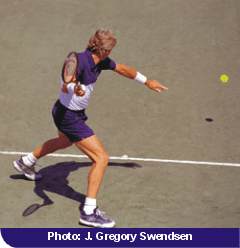|
TennisOne Lessons
One universal problem I see when people come to my
teaching court or camps is poor preparation on the forehand groundstroke.
If this fundamental element is incomplete or poor it is
likely the stroke will never reach its potential. Using pictures of some
of the world’s great pros as examples, let’s examine the elements of
sound forehand preparation. Watching the BallGood preparation for any stroke starts with effective use of the eyes. Firstly, by using your eyes, you’ll know when to make an all-important ready hop. Just before your opponent strikes the ball it’s crucial to make a balanced ready hop. You want to try to time the landing of the hop so the feet touch the ground just as your opponent hits the ball. This will set your leg muscles to move one way or the other; knowing when to ready hop means you’ll respond more quickly and accurately because you’re assessing physical cues your
Using your eyes effectively is also critical in
avoiding a problem I see constantly, the inability to
establish the correct lateral distance from the ball. Players will
actually place their bodies where their racquets need to be, in great part
because they don’t track the ball long enough or with a still enough
head to avoid overreacting while establishing position. Keep your head
still, your shoulders level, and watch the ball until you hear it hit your
strings. There are two other means of establishing a better range of
contact that will be mentioned momentarily. Turning the BodyOnce you’ve established the ball is coming to the
forehand side, initiate a unit turn, or the “coiling” phase of the
stroke. The hips, trunk, and shoulders, in that order, rotate back until
the shoulders are sideways to the target. The racquet is actually the last
part of this kinetic chain.
In conjunction with this turn, the non-racket arm
moves across the body to form an approximately 90-degree angle with the
plane of the shoulders. Most pros will keep the non-hitting hand on the
racquet throat to help initiate the turn and ensure the position of the
arm before letting go. The position of the non-racket arm can also assist
in distancing yourself laterally from the ball. Keeping the ball at that arm’s length will prevent crowding of the swing. Additionally, it helps
assists overall balance and sets up a synchronization of the arms during
the forward swing. Just before the forward rotation of the shoulders,
the wrist should be locked into a laid back position and the elbow should
be bent and relatively tight against the body. At the same time, the
racquet head should be in front of the plane of the shoulders.
Now you’re ready to pull the trigger. In the next article I’ll talk about how to best utilize good preparation and complete the forehand ground stroke package.
Your comments are welcome. Let us know what you about think Scott Murphy article by emailing us here at TennisONE. Scott Murphy is one of America's top teaching pros. He is the director of the Nike Tahoe Tennis Camp. He has taught privately in Marin County, California for twenty years. A high level senior player, Scott has been ranked numerous times in both singles and doubles in Northern California. Scott is already well known to TennisONE readers for his great "Ask the Pro" answers.
|
Last Updated 6/1/00. To contact us, please email to: webmaster@tennisone.com TennisONE is a registered trademark of TennisONE and SportsWeb ONE; Copyright 1995. All rights reserved. |
|||||||




